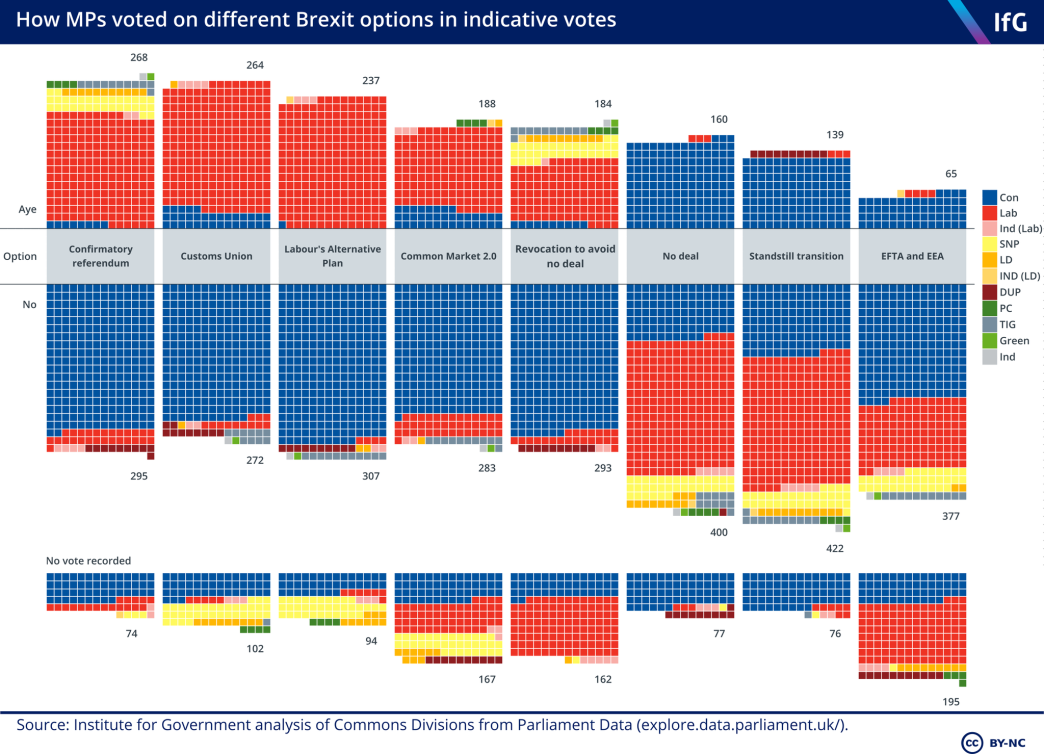The winners, losers and ones to watch from the Brexit indicative votes
The results of the indicative votes illustrate where (and how) consensus over Brexit might emerge.
All of the proposed options were defeated when MPs ‘took back control’ of the Brexit process through a series of indicative votes – but the results still illustrate where (and how) consensus might emerge, writes Maddy Thimont Jack.
Most votes went to a second referendum but this doesn’t resolve the question of what deal
The idea of a ‘confirmatory vote’ on a Brexit deal proved most popular amongst MPs, with 268 voting in favour. This was seen as a win by campaigners for a ‘People’s Vote’, but big questions remain unanswered if a majority MPs do end up supporting a second referendum.
MPs voted to put ‘a deal’ to another referendum, but they didn’t indicate whether they would accept this being Theresa May’s deal or whether they want to put forward an alternative.
It is also difficult to see where additional votes will come from. Labour have already whipped in favour of another referendum, so it would need a shift in the Government’s approach to get it over the line.
‘Common Market 2.0’ isn’t dead yet
Before the vote, there were predictions that the so-called ‘Common Market 2.0’ – which would see the UK join the European Economic Area and European Free Trade Association and take part in a customs union with the EU – could unite MPs. Instead, it came fourth: only 188 MPs voted in favour of it. Of the ‘soft Brexit’ options, forming a permanent customs union was much more popular and lost by only four votes.
But don’t rule out Common Market 2.0 just yet. It could get through to the next round of indicative votes held on Monday and although 283 MPs opposed it, a huge number (167) abstained. Moreover, the Labour frontbench (including Jeremy Corbyn) largely supported it. If Labour’s alternative plan (which is never likely to gain cross-party support) is ruled out, then they may to decide to throw their full support (and whip) behind it as a compromise option.
The DUP may be willing to back a softer Brexit
While the votes were being counted, and following Theresa May’s last-ditch attempt to win her MPs round to her deal by announcing her decision to stand down, the DUP ruled out supporting or abstaining on Theresa May’s deal. “The DUP do not abstain on the Union”, tweeted Nigel Dodds, the DUP’s leader in Westminster, with the party refusing to accept a Northern Ireland backstop which may lead to some regulatory divergence between Northern Ireland and the rest of the UK (whatever guarantees the UK Government may offer).
The DUP voted against a referendum, a customs union, Labour’s plan and Article 50 revocation. But, as a straw in the wind of where they might go, they abstained on two of the ‘softer Brexit’ options – the prospect of staying in the European Economic Area (the single market) as well as the ‘Common Market 2.0’ option. Both these options would ensure there is no border in the Irish Sea. With the Union of paramount importance and if they want to respond to domestic business pressures, then the DUP might end up moving to one of the soft Brexit options.
A lot of MPs didn’t participate
It was not just the DUP who chose to abstain on some of the options put before Parliament. While 28 Cabinet Ministers were instructed to abstain, the rest of the party were given free votes on the different Brexit options and the number of abstentions were high. In addition to Cabinet, 17 Conservatives abstained on the customs union vote, and 24 on ‘Common Market 2.0’.
If these MPs choose to vote in a second round then they could end up being decisive. In particular, the SNP and Liberal Democrats who voted for a second referendum or revocation but abstained on the ‘softer’ Brexit options could, if they think that their preferred options are off the table, end up securing a majority for a softer Brexit option. For example, the Independent Group actually voted down the option for a permanent Customs Union.
The two main political parties remain divided
What was very clear from the votes is that both Labour and the Conservative party are deeply divided. The options which favoured no deal gained a majority of Conservative support (from MPs largely opposed to the prospect of a softer Brexit) but there was also a core group of Labour MPs who actively opposed another referendum despite being whipped to back one.
As Theresa May looks to bring back her deal for a third vote, those same Labour MPs may yet prove decisive in getting it through. But nothing is guaranteed.
The least popular option amongst MPs was leaving the EU without a deal but, as the Institute for Government has repeatedly said, voting against no deal does not change the legal default.
If MPs, or parties, are not willing to compromise on any of the proposed options – a second round of indicative votes will be held on Monday - or compromise to support Theresa May’s deal, the continuing stalemate makes an ‘accidental’ no deal a very real possibility.

- Topic
- Brexit
- Political party
- Democratic Unionist Party
- Administration
- May government
- Publisher
- Institute for Government